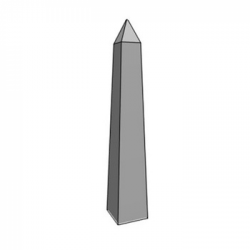Obelisk

The obelisk is an architectural feature that originated in ancient Egypt. Although simple in design, the crafting and transportation of these monolithic masterpieces was a highly involved process, and the form itself took on a number of important symbolic meanings.
The basic form of the Egyptian obelisk was a rectangular pillar topped with a pyramid-shaped cap and often decorated with carved hieroglyphics. Although variations of this form existed in other cultures, this article will focus primarily on the Egyptian variety.
One of the most basic symbolic meanings of the obelisk was as an image of the sun’s rays. Solar worship was a prime religious belief among the ancient Egyptians, and the fact that sunbeams appear to flare out (i.e. get wider) as they move away from the sun itself is the reason why obelisks are typically wider at the base than they are near the top. It has also been suggested that obelisks functioned as an early form of sundial, the falling shadow from the pillar indicating the sun’s position in the sky. Building on these themes, the hieroglyphs found on many obelisks are often dedicated to the sun god Amun-Re (or “Ra” for short). In fact, one of Egypt’s most remarkable rulers, the Pharaoh Hatshepsut (ruled during the 15th century B.C.E.), erected a number of impressive obelisks during her reign. The obelisks not only reinforced the status of Hatshepsut’s political power, but also functioned as propaganda boards, proclaiming her descent from the life-sustaining sun god.
Due to its shape, the obelisk has also been viewed as a phallic symbol, along with many similarly shaped architectural features. Regardless of symbolism, however, the obelisk had a lasting effect on human culture long after Egyptian civilization came to an end. The modern-day city of Rome contains more Egyptian obelisks than Egypt itself; historical specimens have been shipped as far away as London, Paris and New York; and the form itself had a profound influence on later architecture, with obelisk variations appearing in structures around the world (notably the Washington Monument in Washington D.C.).
© Symbols.com
